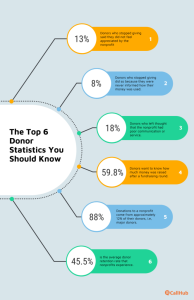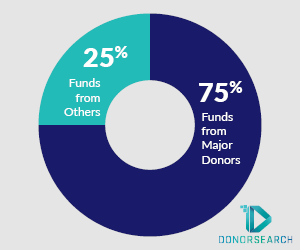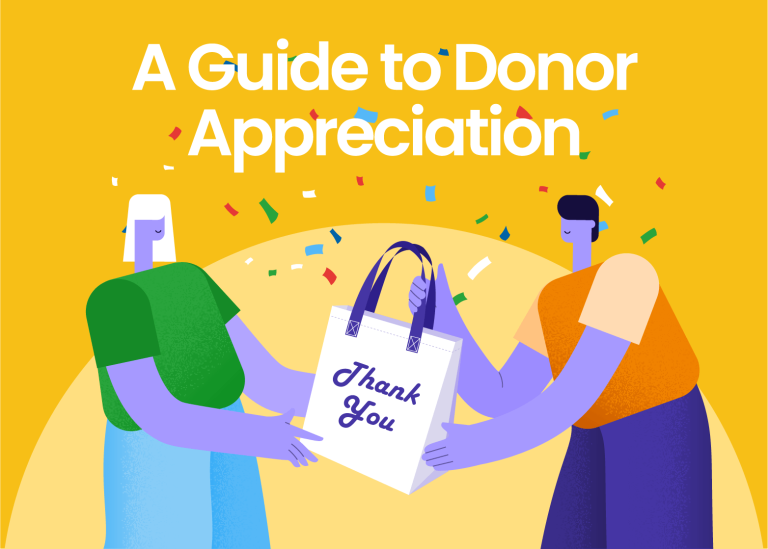The folks who donate to your cause are everything for a nonprofit organization. They’re the ones who are pouring in sweat, hours, and dollars to make sure it succeeds. They believe in your mission and trust you to make a difference—and donor appreciation matters to keep them engaged.
Letting people know you genuinely appreciate them goes beyond mere kindness. It’s what keeps relationships thriving and participants fully on board over time.
But let’s be real: a generic “thank you” email or boring newsletter just won’t cut it. Your donors deserve to feel truly valued and connected to the impact they’re making. That’s where creative donor appreciation comes in.
Ready to take your gratitude game to the next level? Let’s explore unique and meaningful ways to make your donors feel like the heroes they are.
Today, we’ll share:
- Importance of Donor Appreciation
- Creative Donor Appreciation Ideas
- Planning a Successful Donor Appreciation Event
- Strong Donor Recognition Ideas for Major Donors and Recurring Donors
- Leveraging Technology for Donor Appreciation
- Measuring the Impact of Donor Appreciation Efforts
- Engaging Your Team in Donor Appreciation
- Donor Recognition is the Most Important Activity for Nonprofits
Importance of Donor Appreciation
As a nonprofit leader, we’ve seen firsthand the power of donor appreciation in building lasting relationships with supporters among our client base. It’s not just about saying “thank you.” It’s about making donors feel truly valued and connected to your mission.
Think about it this way: your donors are investing in your cause, and they want to know that their contributions are making a real difference. By showing genuine gratitude and keeping them in the loop about the impact of their gifts, you’re nurturing a sense of partnership and trust.
Benefits of donor appreciation
So, what are the concrete benefits of a strong donor appreciation strategy?
For starters, it can lead to higher retention rates.
But the benefits go beyond just securing repeat donations. By cultivating strong relationships with your supporters, you’re also laying the groundwork for larger gifts down the line and valuable word-of-mouth referrals. Happy donors make great ambassadors for your cause.
Building long-term relationships
Of course, building those kinds of deep, lasting connections with donors takes more than just a one-time thank-you note. It requires a sustained effort to communicate impact, share stories, and make donors feel like true partners in your work.
One powerful way to do this is through donor appreciation events, which are a good time to engage with supporters face-to-face and celebrate their contributions to specific projects or overall.

Whether it’s a virtual tour of your facility, a volunteer opportunity, or an exclusive behind-the-scenes look at your programs, these events help donors see the tangible results of their giving and spark a personal connection.
Improving donor retention rates
Ultimately, a robust donor appreciation strategy is about more than just hitting fundraising targets – it’s about building a community of loyal, engaged supporters who are invested in your long-term success. And that starts with making gratitude a core part of your organizational culture.
So, if you’re looking to boost retention rates, strengthen donor relationships, and create a more sustainable fundraising model, don’t underestimate the power of a heartfelt “thank you.” It may seem like a small gesture, but it can make a world of difference in the eyes of your donors.
Creative Donor Appreciation Ideas
Now that we’ve covered the importance of donor appreciation, let’s dive into some creative ways to show your gratitude.
Coming up with new and innovative ideas for donor recognition can be difficult, but it’s so incredibly important to ensure your mission is able to create lasting change.
Personalized thank-you letters
While it may seem too simple to be a solid appreciation idea, a thank-you letter goes a long way.
One of the most effective ways to make donors feel valued is through a personalized thank-you letter—even better if it’s handwritten and accompanied by appreciation gifts. But, we’re not talking about a generic form letter. This must be a heartfelt, customized donor recognition message that speaks directly to the donor’s interests and impact.
For example, if a donor gave to a specific program or campaign, highlight how their gift is making a difference in that area. Share a story or testimonial from someone who benefited from the program, or have them write the message even.

Don’t be afraid to get creative with the format—a handwritten note or a video message can really stand out in a sea of email inboxes.
Donor appreciation events
Another powerful way to show gratitude is through donor appreciation events.
These can range from small, intimate gatherings to large-scale celebrations, depending on your budget and goals. Member and donor mixers are also a fun social gathering to host!
One idea that’s worked well for our client organizations are “behind-the-scenes” events, where major donors are invited to tour the facility and meet with staff and beneficiaries. It’s a great way to give them a firsthand look at the impact of their giving, and to make them feel like true insiders.
Thoughtful donor recognition gifts
While donor appreciation doesn’t have to involve physical gifts, a thoughtful token of your gratitude can go a long way. The key is to choose something that aligns with your mission and values, and that feels personal to the donor.
For example, if your organization works in environmental conservation, you might send donors a small plant or seedling to symbolize the growth and impact of their gift. Or if you work with children, you could include a piece of artwork or a heartfelt note from one of the kids your programs serve.
Phone calls and personal outreach
Sometimes, the most meaningful gestures are the simplest ones. Taking the time to pick up the phone and personally thank a donor can be incredibly powerful—especially in an age where nearly every appreciation idea and form of communication stems from something online.
When you call, focus on listening as much as talking. Ask the donor about their connection to your cause, and what inspired them to give. Share a brief update on your work, and let them know how much their support means to you.
Be sure that these calls are made in a timely manner. They’ll be even more effective—and you may even get a recurring donation.
Social media shoutouts
For donors who are active on social media, a public shoutout can be a fun way to show your appreciation. Just be sure to get their permission first by adding a checkbox or something to your donation form, and to keep the message focused on gratitude rather than solicitation.
You might share a photo of the donor volunteering at your organization, or highlight a quote from them about why they support your mission. Tagging them in the post can help spread the word to their own networks and may even inspire others to give.
Branded merchandise
Finally, don’t underestimate the power of branded merchandise as a donor appreciation tool. Giving supporters a tangible reminder of your organization like a t-shirt, tote bag, or coffee mug. It’s a great recognition strategy that can help keep your cause top-of-mind long after the initial gift.
Plus, when donors use or wear your branded items out in the world, they become walking billboards for your mission. It’s a win-win: they get a useful gift, and you get some extra visibility and awareness.
The bottom line? There are endless ways to show your donors some love – the key is to get creative, stay true to your mission and values, and always lead with gratitude. Your supporters will notice the difference, and your fundraising will be all the stronger for it.
Planning a Successful Donor Appreciation Event
Since hosting a donor appreciation event is one of the best ways to show your gratitude and make your supporters feel valued, we want to help with some tips for where to start. You have to craft messages from the beginning for donors’ events.
Choosing the right type of event
First things first, you need to decide what type of event will resonate most with your donors.
Will it be a formal sit-down dinner?
A casual happy hour?
An interactive workshop?
Consider your audience and what would make them feel most appreciated.
For example, if you have a lot of young professionals, a trendy cocktail party might be a hit. But if your donors are mostly retirees, a daytime luncheon could be a better fit.
Setting a budget
Once you have a vision for your event, it’s time to crunch the numbers. Your budget will dictate everything from the venue to the catering to the decor.
Be realistic about what you can afford, but don’t be afraid to get creative. We’ve seen clients throw some amazing donor recognition events on a shoestring budget by being resourceful and thinking outside the box.
Selecting a venue
The venue sets the tone for your entire event, so choose wisely. Look for a space that aligns with your theme and can comfortably accommodate your guest list.
If you’re on a tight budget, consider unconventional spaces like art galleries, community centers, or even outdoor parks. These can be just as impactful as a fancy ballroom if you get creative with the setup and decor. You can even use your own facility and offer tours!
Creating an engaging program
Your event shouldn’t just be a chance for donors to mingle and enjoy a meal. It should also be an opportunity to showcase the impact of their contributions and make them feel like part of your mission.
Consider including elements like a keynote speech from a beneficiary, a video montage of your work in action, or interactive displays that bring your cause to life. The goal is to create an emotional connection and remind donors why their support matters.
Sending invitations
Your appreciation event invitations should be more than just a date and location. They should build excitement and make donors feel special and valued.
Personalize each invitation with the donor’s name and consider including a handwritten note from your executive director or board chair. These small touches can go a long way in making donors feel appreciated.
It’s simple to customize invitations when you have a data management system that helps you keep track of the important details, like Stratly does!
Following up after the event
Your work isn’t done when the event is over. Following up with donors is just as important as the event itself.
Send a personalized thank-you note to each attendee, along with photos or videos from the event. You can also use this opportunity to share any exciting updates or milestones that were announced at the event.
By showing your appreciation before, during, and after the event, you’ll cultivate strong relationships with your donors and keep them engaged with your mission for the long haul.
Strong Donor Recognition Ideas for Major Donors and Recurring Donors
Another thing to think about is that while every donor deserves to feel appreciated, there are two groups that warrant some extra special donor recognition: major donors and recurring donors.
These are the supporters who go above and beyond with their contributions, and it’s important to recognize their dedication in a meaningful way that goes far beyond a typical donor appreciation gift.
Special recognition for major donors
Major donors are the backbone of most fundraising campaigns. They make significant contributions that can transform your organization’s work and impact.

To show your gratitude, consider creating a special recognition program just for major donors. This could include perks like exclusive events, personalized updates from leadership, or even naming opportunities for programs or facilities. It’s smart to create a strategy guide with gift ideas that your development team can come back to with major donors recurring giving.
The key is to make major donors feel like they are part of an inner circle and that their contributions are truly making a difference.
Acknowledging recurring donors
Recurring donors are another group that deserves some extra love. These are the supporters who commit to giving on a regular basis, providing a reliable stream of funding for your organization.
To show your appreciation, consider sending a special thank-you gift or note each year on the anniversary of their first donation. You can also highlight recurring donors in your annual report or newsletter to showcase their ongoing impact.
Another idea is to create a special event just for recurring donors, like a behind-the-scenes tour of your facility or a Q&A with your leadership team. This can help strengthen their connection to your mission and make them feel valued as long-term partners.
Creating a donor recognition wall
A donor recognition wall is a classic way to honor your most generous supporters. It’s a physical display that showcases the names of donors who have made significant contributions to your organization.
But a donor wall doesn’t have to be boring or traditional. Get creative with the design and make it interactive or visually stunning. You could even create a digital version that can be updated in real-time and shared on social media.
We have a whole post with ideas here that you can use for one-time donors up to major donors.
The goal is to create a focal point that celebrates your donors and inspires others to give. It’s a powerful way to show your appreciation and create a sense of community around your cause.
Offering exclusive perks and benefits
Another way to recognize major donors and recurring donors is by offering exclusive perks and benefits. These could be anything from personalized reports on the impact of their giving to quarterly chats with the organization’s CEO or board members.
One other idea is to create a donor loyalty program, where supporters earn points or rewards for their contributions. For example, donors who give a certain amount each year could receive a special gift or invitation to an exclusive event.
The key is to create memorable moments that are innately showing appreciation.
By going above and beyond to recognize your most dedicated supporters, you’ll build stronger relationships and inspire even greater generosity in the future.
Leveraging Technology for Donor Appreciation
As a nonprofit, you know how important it is to show your donors just how much they mean to you. But with limited time and resources, it can be tough to give each and every supporter the personalized attention they deserve.
That’s where technology comes in. By leveraging the right tools and strategies, you can take your donor appreciation efforts to the next level – without breaking the bank or burning yourself out in the process.
Using social media to showcase donor impact
Social media is a powerful tool for nonprofits looking to connect with their supporters. And when it comes to donor appreciation, it’s a great way to publicly recognize your donors and showcase the impact of their contributions.
Consider creating social media posts that highlight specific donors and the projects or programs they’ve helped fund. Share photos, videos, and stories that bring their impact to life and make them feel like the heroes they are.
Here’s an example:
We are incredibly grateful to our donors who make our work possible. Your support helps us provide essential services to those in need. Thank you for being a part of our mission. #DonorAppreciation #NonprofitImpact
— YourNonprofit (@YourNonprofit) May 6, 2024
You can even create a dedicated hashtag for your donor appreciation posts, like #DonorLove or #ImpactMakers, to make them easy to find and share.
Sending personalized email newsletters
Email newsletters are another great way to keep your donors in the loop and show them how much you appreciate their support. But instead of sending generic updates to your entire list, try segmenting your donors based on their interests, giving history, or engagement level.
This allows you to craft more targeted, personalized messages that resonate with each donor. You can highlight specific programs they’ve supported, share stories of the lives they’ve touched, and even include a personal note of thanks from your executive director or a beneficiary of your services.
Stratly helps teams organize this with all donors.
Utilizing donor management software
Of course, none of this is possible without the right donor management tools in place. Investing in a robust CRM (customer relationship management) system can help you keep track of your donors’ preferences, giving history, and engagement levels, so you can tailor your appreciation efforts accordingly.
Look for a system that allows you to easily segment your donors, automate personalized communications, and track the impact of your appreciation efforts over time. With the right software in place, you’ll be able to build stronger, more meaningful relationships with your donors – without sacrificing precious time and resources.
Leveraging data to tailor appreciation efforts
Finally, don’t forget the power of data when it comes to donor appreciation. By tracking key metrics like donor retention rates, average gift size, and engagement levels, you can gain valuable insights into what’s working (and what’s not) in your appreciation efforts.
Use this data to continually refine and optimize your strategy over time. Test different approaches, measure their impact, and double down on the tactics that deliver the best results for your organization and your donors.
Measuring the Impact of Donor Appreciation Efforts
Donor appreciation isn’t just a nice thing to do – it’s a critical component of any successful fundraising strategy. By making your donors feel valued and connected to your mission, you can build lasting relationships that lead to increased giving, advocacy, and overall support for your cause.
But how do you know if your appreciation efforts are actually making a difference? That’s where impact measurement comes in.
Tracking donor retention rates
One of the most important metrics to track when it comes to donor appreciation is your donor retention rate. This measures the percentage of donors who give to your organization year after year, and it’s a key indicator of the strength of your relationships with your supporters.
To calculate your donor retention rate, simply divide the number of donors who gave both this year and last year by the total number of donors who gave last year. For example, if you had 100 donors last year and 60 of them gave again this year, your donor retention rate would be 60%.
Analyzing fundraising data
In addition to tracking donor retention, it’s important to track fundraising and overall donor analytics to see how your appreciation efforts are impacting your bottom line. Look for trends in giving levels, frequency of donations, and response rates to your appeals and campaigns.
If you notice an uptick in giving after implementing a new appreciation tactic, like sending personalized thank-you videos or hosting a donor recognition event, that’s a good sign that your efforts are paying off.
Gathering feedback from donors
Of course, the best way to know if your appreciation efforts are resonating with your donors is to simply ask them. Consider sending out a survey or conducting focus groups to gather feedback on what your donors love (and what they don’t) about your appreciation tactics.
Ask questions like:
- What makes you feel most appreciated as a donor?
- What types of communication do you prefer to receive from us?
- How can we make you feel more connected to our mission and impact?
Use this feedback to continually refine and improve your donor relations strategy over time.

Continuously refining your appreciation strategy
Finally, remember that donor appreciation is an ongoing process, not a one-time event. As your organization grows and evolves, so too should your approach to thanking and recognizing your supporters.
Make it a habit to regularly review your appreciation tactics, measure their impact, and make adjustments as needed. Stay up-to-date on best practices and emerging trends in the field, and don’t be afraid to try new things and take calculated risks.
By continuously refining your donor appreciation strategy, you’ll be able to build a loyal, engaged community of supporters who are passionate about your cause and committed to your long-term success.
Engaging Your Team in Donor Appreciation
Donor recognition is about recognizing the values you share with your donors. Taking advantage of donor appreciation event ideas can help you find unique ways to show your gratitude without breaking your budget. Connect with your donors to show them how much their gifts impact your mission and help your community.
But you can’t do it alone. Engaging your entire team in the donor appreciation process is key to making your supporters feel truly valued. From your board members and executive director to your staff and volunteers, everyone has a role to play in expressing gratitude.
Involving Board Members and Leadership
Your board members and executive director set the tone for your organization’s culture of appreciation. They should be actively involved in thanking donors, whether it’s through personal phone calls, handwritten notes, or face-to-face interactions at events.
Encourage your leadership team to share their own stories of why they give and what inspires them about your work. This authentic connection can be incredibly powerful in strengthening donor relationships.
Encouraging Staff Participation
Your staff are the ones on the front lines, delivering your programs and services. They see firsthand the impact of donor generosity. Empower them to express their appreciation whenever they interact with supporters.
At one of our client’s donor appreciation events, they had staff members stationed at different areas to chat with guests about their specific programs. Donors loved hearing directly from the people making a difference with their support. It gave them a deeper understanding of their impact.
You can also involve staff in brainstorming creative ways to say thank you or in writing personal notes to donors they’ve worked with closely. The more your team is engaged, the more genuine and heartfelt your appreciation will be.
Offering Volunteer Opportunities for Donors
Giving donors the chance to volunteer is a win-win. They get an inside look at your work while also feeling good about contributing their time and talents. Plus, volunteers are almost twice as likely to donate as non-volunteers according to AmeriCorps.
Consider creating special volunteer roles for donors at your next event or inviting them to serve on a committee. You could even organize a donor-only volunteer day where they can work alongside staff and see your mission in action.
Exploring Volunteer Grants and Matching Gift Programs
Many companies offer volunteer grants and matching gift programs to encourage their employees to give back. This is a great way to deepen donor engagement while also leveraging additional funds for your cause.
Research which of your donors’ employers offer these programs and make it easy for them to take advantage. Provide clear instructions on your website and in your communications. You can even highlight donors who have utilized these opportunities to inspire others.
The bottom line?
Engaging your entire team in donor appreciation creates a culture of gratitude that permeates everything you do. When donors feel genuinely valued, they’ll be more likely to stick with you for the long haul. And that’s what true appreciation is all about.
Donor Recognition is the Most Important Activity for Nonprofits
Donor appreciation is so much more than a transaction or an obligation. It’s all about forging lasting relationships, finding delight in shared experiences, and shaping the world around us. By putting thought and heart into how you thank your supporters, you’re not just showing gratitude—you’re inviting them to be an integral part of your mission.
So go ahead and get creative, have fun, and most importantly, let your appreciation shine through. Your donors will feel the love, and your nonprofit will reap the rewards of a loyal, engaged community that’s in it for the long haul.
If you need support managing donor data so you can optimize your donor recognition efforts and streamline data management, schedule a Stratly demo today.

